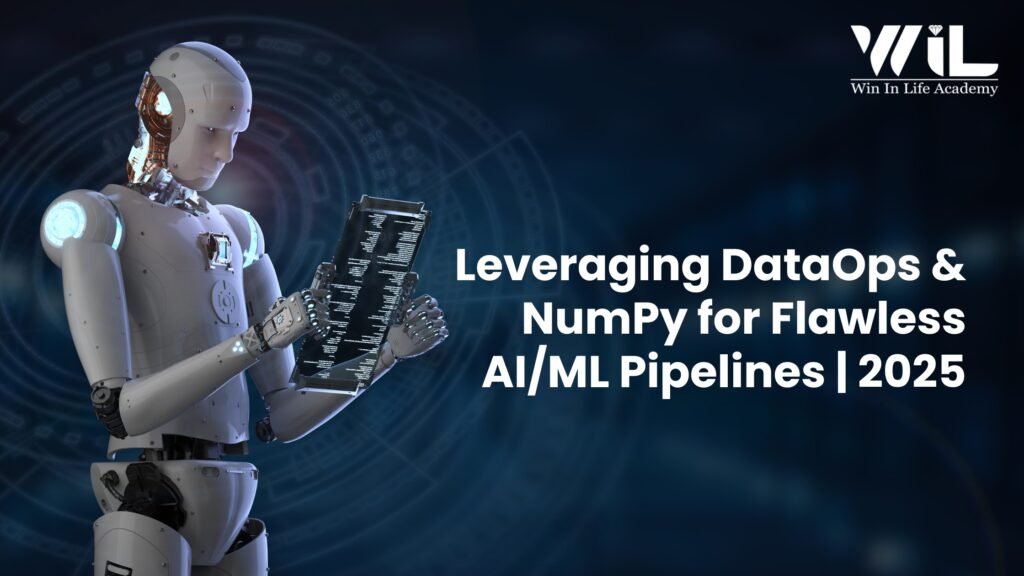The spotlight often shines brightest on complex algorithms, sophisticated models, and groundbreaking research in artificial intelligence and machine learning. We talk about deep learning architectures, reinforcement learning paradigms, and the magic of predictive analytics. Yet, beneath this glittering surface lies a foundational truth: without robust, reliable, and readily available data, even the most ingenious algorithms will still render. Data is the lifeblood of AI/ML and managing that lifeblood effectively is where many projects get delayed.
This is where the principles of DataOps emerge as a critical discipline. Often seen as the operational counterpart to DevOps, DataOps extends the same philosophy of automation, collaboration, and continuous improvement to the entire data lifecycle. And within the technical toolkit of any aspiring AI/ML professional, one library stands out for its fundamental role in data manipulation and numerical computation: NumPy.
This blog post will delve into how DataOps, empowered by the numerical prowess of NumPy, can transform your AI/ML projects from hazardous data expeditions into streamlined, efficient, and reliable data-driven initiatives. We’ll explore how these two seemingly disparate concepts – a high-level operational philosophy and a low-level numerical library – intersect to address critical challenges in data governance, establish effective CI/CD for data, optimize metadata management, and build truly automated data pipelines.
Enroll Now: AI and ML course
Operationalizing Data: The DataOps Principles
Before DataOps, data management in many organizations was often fragmented. Data engineers, data scientists, and operations teams often worked in isolation, leading to inconsistencies, delays, and a lack of trust in the data itself. The insights derived from such data, no matter how brilliant the data scientist was, were always under a shadow of a doubt.
DataOps seeks to bridge these gaps by applying Agile and Lean manufacturing principles to data management. Its core principles include:
- Collaboration and Communication: Breaking down silos between data producers, consumers, and IT operations.
- Automation: Automating manual tasks across the data lifecycle, from ingestion to transformation and delivery.
- Monitoring and Observability: Continuously monitoring data quality, pipeline performance, and system health.
- Version Control and Reproducibility: Ensuring that data assets and transformations are versioned and can be reliably reproduced.
- Continuous Integration/Continuous Delivery (CI/CD) for Data: Applying CI/CD principles to data pipelines to accelerate development and deployment while maintaining quality.
- Data Quality and Governance: Proactively managing data quality and adhering to regulatory and organizational governance policies.
In essence, DataOps isn’t just a set of tools; it’s a cultural shift. It’s about creating a data-driven culture where data is treated as a product, continuously improved, and delivered with high quality and speed. For AI/ML, where model performance is directly tied to data quality and consistency, this shift is not just beneficial – it’s absolutely essential.
NumPy: The Foundational Numerical Engine for AI/ML Workflows

Now, let’s focus on a tool that every AI/ML practitioner encounters early in their journey: NumPy (Numerical Python). While DataOps provides the strategic framework, NumPy provides the tactical muscle for numerical operations on vast datasets.
At its core, NumPy provides a powerful N-dimensional array object, designed for efficient storage and manipulation of large datasets. This array object is significantly more efficient than Python’s built-in lists for numerical operations, primarily due to its underlying implementation in C and Fortran.
Consider typical AI/ML tasks:
- Feature Engineering: Creating new features from raw data often involves complex mathematical operations, aggregations, and transformations on numerical arrays.
- Data Preprocessing: Scaling, normalization, imputation of missing values – these are all numerical operations that benefit immensely from NumPy’s efficiency.
- Model Training: The core of most machine learning algorithms, from linear regression to neural networks, involves matrix multiplications, dot products, and other linear algebra operations, all of which are optimized in NumPy.
- Image and Signal Processing: Representing images as multi-dimensional arrays (pixel values) and applying filters or transformations heavily relies on NumPy.
- Data Visualization: Preparing data for plotting libraries like Matplotlib often involves converting data into NumPy arrays.
Without NumPy, performing these operations in pure Python would be bitterly slow and resource-intensive, making large-scale AI/ML practically non-viable. NumPy’s optimized operations are a cornerstone of the data processing backbone that fuels AI/ML models.
DataOps Principles and NumPy’s Role

This is where magic happens. How does a high-level philosophy like DataOps leverage a low-level library like NumPy? It’s through the practical application of DataOps principles in the daily development and deployment of AI/ML solutions.
1. Data Governance: Ensuring Data Integrity with NumPy’s Precision
Data Governance is a cornerstone of DataOps. It’s about defining policies and procedures for how data is collected, stored, processed, and used. For AI/ML, this means ensuring that the data used for training and inference is accurate, consistent, compliant, and trustworthy.
NumPy plays a crucial role here. When you perform data cleaning and transformation using NumPy, you are directly contributing to data governance.
- Handling Missing Values: Using np.nan and then strategies like np.nanmean, np.nanmedian to attribute missing values consistently across datasets. This ensures that your missing data strategy is standardized, a key aspect of governance.
- Data Type Enforcement: NumPy arrays enforce uniform data types, which helps prevent subtle data inconsistencies that could lead to errors down the line. For example, ensuring a column of ages is always int64 and not a mix of strings and integers.
- Outlier Detection and Treatment: Employing NumPy for statistical analysis (e.g., standard deviation, IQR) to identify and treat outliers in a governed manner, preventing skewed models.
- Data Validation: Writing validation scripts that leverage NumPy’s array operations to check for data ranges, distributions, or specific patterns. These scripts can be integrated into your data pipelines as checks, flagging non-compliant data early.
By standardizing these data preparation steps with NumPy, DataOps ensures that data is consistently processed and adheres to defined quality standards, thereby strengthening Data Governance.
2. CI/CD for Data: Automating and Testing Data Transformations
Just as software development benefits from Continuous Integration and Continuous Delivery (CI/CD), so do data pipelines. CI/CD for Data means automating the process of testing, integrating, and deploying data transformations and models. This ensures that changes to data pipelines are thoroughly validated before they impact production systems.
NumPy is fundamental to the testing and validation steps within a data CI/CD pipeline:
- Unit Testing Data Transformations: Imagine a transformation function that scales a numerical feature. You can write unit tests using NumPy arrays as input and assert that the output array matches the expected scaled values.
Python
import numpy as np
def scale_feature(arr):
return (arr – np.mean(arr)) / np.std(arr)
# In your test file
def test_scale_feature ():
data = np.array([1.0, 2.0, 3.0, 4.0, 5.0])
expected_scaled = np.array([-1.41421356, -0. 70710678, 0.0.70710678, 1.41421356
#Example
assert np. Allclose(scale-feature(data), expected_scaled)
- Data Contract Testing: As data schemas evolve, you need to ensure that downstream consumers are not broken. NumPy can be used to quickly generate synthetic data conforming to specific schemas for testing purposes, ensuring compatibility.
- Regression Testing Data: When a change is made to a data pipeline, you can run previous versions of the pipeline on the same historical data and compare the NumPy array outputs to ensure no unintended regressions have occurred. Np.allclose() is invaluable here for comparing floating-point arrays.
- Performance Benchmarking: CI/CD pipelines can include performance tests that measure the execution time of NumPy-intensive data processing steps, ensuring that performance doesn’t degrade with new changes.
By embedding NumPy-based tests into your CI/CD pipelines, you build a robust safety net, accelerating development cycles while maintaining data quality and reliability.
3. Metadata Management: Documenting and Understanding Your Data
Metadata Management is about capturing and making accessible information about your data – its schema, lineage, quality metrics, transformations applied, and more. Effective metadata management is crucial for understanding data, ensuring its correct use, and debugging issues.
While NumPy doesn’t directly manage metadata in the way a dedicated metadata catalog system does, it enables the very processes that generate valuable metadata:
- Transformation Lineage: Every time you apply a NumPy operation (e.g., np.mean(), np.reshape(), np.linalg.svd()), you are performing a transformation. Documenting these steps, including the specific NumPy functions used and their parameters, provides crucial lineage information. This can be automatically extracted and stored as metadata.
- Data Quality Metrics: NumPy is used to calculate various data quality metrics – mean, standard deviation, number of NaNs, unique values, etc. These metrics are vital metadata that can be stored and monitored over time, providing insights into data health.
- Schema Inference: While not directly a NumPy function, tools that infer schemas often process data as NumPy arrays to determine data types and structures, contributing to schema metadata.
- Profiling Data: NumPy’s statistical functions are indispensable for profiling datasets. The results of this profiling (e.g., min/max values, quartiles, distribution shapes) become rich metadata that helps users understand the characteristics of the data.
By automating the extraction of these NumPy-driven insights and integrating them into a comprehensive metadata management system, organizations can create a clearer, more traceable picture of their data assets.
4. Automated Data Pipelines: Building Seamless Data Flows with NumPy
The goal of DataOps is to create Automated Data Pipelines that move data efficiently, reliably, and without manual intervention from source to consumption. For AI/ML, this means pipelines that ingest raw data, preprocess it, potentially train models, and then serve predictions.
NumPy is the workhorse within the processing nodes of these pipelines:
- ETL (Extract, Transform, Load) Processes: When data is extracted and loaded, the ‘Transform’ stage often involves heavy numerical computation. NumPy arrays are the ideal data structure for these transformations, allowing for vectorized operations that are incredibly fast.
- Example: Calculating new features like moving averages or growth rates on time-series data using NumPy rolling windows.
- Example: One-hot encoding categorical features or standardizing numerical features for machine learning models.
- Feature Store Integration: Automated pipelines often feed into feature stores, which require features to be consistently computed and stored. NumPy ensures these computations are efficient and standardized.
- Model Training and Inference: While frameworks like TensorFlow or PyTorch handle deep learning computations, they often interoperate seamlessly with NumPy arrays for data input and output. Automated training pipelines will use NumPy for preparing batch data.
- Error Handling and Robustness: While NumPy itself doesn’t provide pipeline orchestration, its consistent numerical output and predictable behavior make it easier to design robust pipelines where data types and values are as expected. Error handling within transformations can leverage NumPy’s capabilities to identify and flag issues (e.g., division by zero, invalid inputs).
By integrating NumPy-powered processing steps into orchestrated data pipelines, organizations can build highly efficient and scalable AI/ML solutions, ensuring that data is always ready for model consumption.
The AI/ML Curriculum: Where DataOps and NumPy Intersect

In any modern AI/ML curriculum, the emphasis on data is growing. Gone are the days when students could focus solely on algorithms. Today, a well-rounded AI/ML professional needs to understand the entire data lifecycle.
Here’s how DataOps and NumPy should be – and often are – integrated:
- Foundational Data Skills: Early courses introduce Python and NumPy as the fundamental tools for data manipulation and numerical computation. This is where students learn about array operations, broadcasting, indexing, and basic statistical functions.
- Data Preprocessing and Feature Engineering: As students delve into machine learning, they encounter the practical challenges of preparing real-world data. This is where NumPy’s advanced capabilities for handling missing data, scaling, transforming distributions, and creating new features become paramount.
- Software Engineering Best Practices for Data: This is where DataOps truly shines. Curricula are increasingly incorporating modules on version control for data, testing data pipelines, setting up CI/CD for data transformations, and understanding data lineage. While not explicitly teaching “DataOps,” these are its core tenets.
- Big Data Technologies: In courses covering big data ecosystems (e.g., Spark), students learn how distributed computing frameworks often interoperate with NumPy for numerical operations, demonstrating the scalability of these techniques.
- Deployment and MLOps: Advanced courses focus on deploying AI/ML models into production. This is where DataOps principles are crucial for ensuring that the data pipelines feeding these models are robust, monitored, and continuously delivered.
Therefore, the AI/ML curriculum serves as the ideal breeding ground for nurturing professionals who intuitively understand the importance of DataOps, leveraging powerful tools like NumPy to build reliable and scalable AI/ML systems.
Real-World Impact: A Comprehensive Approach
Let’s consider a practical scenario. Imagine a company building a recommendation engine.
- Data Ingestion: Raw clickstream data comes in. NumPy might be used here to initially parse and structure numerical identifiers or timestamps.
- Feature Engineering (NumPy heavy):
- Calculating user engagement metrics (time on page, number of clicks) using NumPy aggregations.
- Creating embeddings from categorical data, where the embedding vectors are handled by NumPy.
- Normalizing numerical features for the recommendation model is important.
- Data Governance (DataOps): Policies dictate how user privacy information is handled. NumPy operations ensure sensitive data is anonymized or aggregated in compliance. Data quality checks (e.g., no negative values for ratings) are performed using NumPy and flagged if issues arise.
- CI/CD for Data (DataOps): Any new feature calculation (e.g., “recency score”) is developed, tested with NumPy, and then integrated into the data pipeline. Automated tests run historical data to ensure the new feature doesn’t break existing logic or introduce errors.
- Metadata Management (DataOps): Details about each feature (e.g., “user_engagement_score – derived from clickstream data, scaled using min-max normalization, computed using NumPy”) are automatically captured, providing transparency and understanding to data scientists.
- Automated Data Pipelines (DataOps): The entire process, from raw clickstream to ready-to-use features for the recommendation model, is automated. If data quality issues are detected (using NumPy-based checks), the pipeline alerts relevant teams.
Without the foundational efficiency of NumPy for numerical transformations and the operational rigor of DataOps, this entire process would be manual, error-prone, and incredibly slow, hindering the company’s ability to iterate on its recommendation engine and deliver value.
To Sum Up
The journey into AI and Machine Learning is exciting, fraught with challenges, and ultimately, deeply rewarding. As we push the boundaries of what intelligent systems can achieve, it becomes increasingly clear that the true bottleneck is often not the algorithms themselves, but the data that fuels them.
DataOps provides a holistic framework, a way of thinking and operating, that ensures your data is a reliable asset, not a constant liability. It’s about building robust processes, fostering collaboration, and embracing automation. And at the heart of many of these automated, efficient data processes in AI/ML, you’ll find the robust and performant numerical capabilities of NumPy.
By understanding and applying DataOps principles – embracing Data Governance, implementing CI/CD for Data, diligently practicing Metadata Management, and building fully Automated Data Pipelines – all underpinned by the power of NumPy, you’re not just building models; you’re building a sustainable, scalable, and trustworthy AI/ML ecosystem.
Are you ready to truly master the art of data and unlock its full potential in your AI/ML journey?
Win in Life Academy offers comprehensive courses designed to equip you with the practical skills and strategic mindset needed to excel in the world of AI and Machine Learning. From foundational data manipulation with NumPy to advanced DataOps strategies for robust deployments, our curriculum is tailored to help you navigate the complexities of real-world data science.
Visit Win in Life Academy today to explore our programs and take the next decisive step towards winning in your AI/ML career and in life! Don’t let data challenges hold you back; empower yourself with the knowledge to transform them into opportunities.
References
Data Operations
https://www.techtarget.com/searchdatamanagement/definition/DataOps
What is DataOps
https://www.geeksforgeeks.org/what-is-dataops
What is DataOps?





